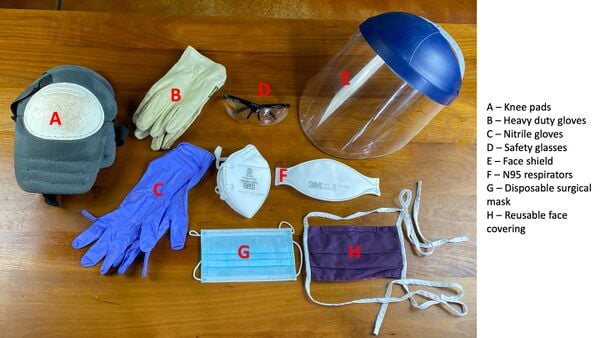
EMS personnel are in the front lines of caring for patients in many different environments which may pose hazards to the care provider. The appropriate use of Personal Protective Equipment (PPE) with care taken in donning and doffing the equipment is essential for on the job safety.
RESPIRATORY ISOLATION[edit | edit source]
The advent of COVID-19 has brought to the forefront the realization that every patient encounter can potentially spread infection from the patient to the provider or from the provider to the patient even when illness is not the chief complaint. Routine use of respiratory protection using Filtering Facepiece Respirators (FFRs) such as N95 respirators for all patient encounters is now mandatory in many counties. In others, local protocols require the use of either disposable surgical masks or high quality reusable face coverings.
GLOVES[edit | edit source]
Nitrile or other form-fitting synthetic glove are an essential part of keeping yourself protected from potentially infectious bodily fluids or chemical contamination in industrial accidents. Put on clean, non-sterile gloves before performing patient care. Change gloves if they become torn or heavily contaminated. Remove and discard gloves after providing patient care, and immediately perform hand hygiene.
Heavy duty leather or synthetic gloves protect your hands from sharp debris and extremes of temperature when assisting patients at the scenes of motor vehicle of industrial accidents.
EYE PROTECTION[edit | edit source]
The eyes are a common route for infection, but the hazards are not limited to infectious spatter - an injured eye from flying debris often results in permanent irreversible blindness. Eye protection should be worn on every encounter. A simple pair of safety glasses or a full Face shield can protect your eyes from ultraviolet radiation, flying particles, sparks, patient assaults and biohazard splatter.
KNEE PROTECTION[edit | edit source]
Knee protection can protect providers from hot asphalt, cold icy roads and biohazards. It can also cushion the knee from the repeated weight of your body and the body you are lifting. Knee protection, whether integrated into pants, or as separate articles of PPE, is good practice.
ISOLATION PPE[edit | edit source]
Transporting patients in isolation require donning full gowns with gloves that fit over the wrist cuffs, respiratory and eye protection. Hospital isolation precautions should be continued in the ambulance. Be familiar with your department protocols for the use of Isolation PPE when indicated.